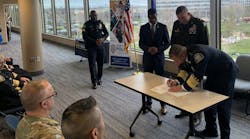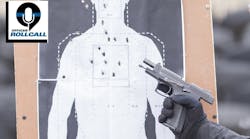ST. LOUIS, Mo. -- A study commissioned by the St. Louis police department recommends that summaries of officer-involved shooting investigations -- complete with disciplinary rulings and the names of officers involved -- be publicly posted on the department's website.
The report from the University of Missouri-St. Louis also urges the force to assign some detectives exclusively to investigate such shootings, and to form a special unit to examine the circumstances of each to look for tactical adjustments that might reduce to need to use deadly force.
In addition, the study suggests more training, in part to address findings that officers who make the decision to shoot hit their targets only less than half of the time.
"Reducing the number of shootings is not the goal, reducing the number of shootings that didn't need to happen is the goal," said David Klinger, the UMSL criminologist who wrote the report. "When officers have good training, then they can anticipate and structure circumstances to reduce the likelihood that a knucklehead is going to take them on."
At the behest of Chief Dan Isom, the department paid UMSL $25,000 to review nearly 100 incidents from 2008 to 2011 in which officers intentionally fired their weapons at people. The department previously paid UMSL $22,500 to analyze 112 officer-involved shootings from 2003-07.
Klinger said the department acted upon some of his previous recommendations but still has "considerable room for improvement."
Isom said he agrees with most of Klinger's recommendations, including public transparency, but he emphasized that implementation would fall to his successor. The chief's last day on the force is Jan. 1. After that, Isom, who holds a doctorate, will become one of Klinger's colleagues at UMSL, working as a criminologist and studying officer-involved shootings across the country.
Reacting to Klinger's analysis, Isom said, "We've gotten better, but we're not good enough."
Those recommendations have been met with mixed reactions among the rank and file.
Sgt. David Bonenberger, president of the St. Louis Police Officers' Association, was among those present for a discussion of Klinger's report a few months ago. He agrees with additional training but fiercely opposes publishing anything about shooting investigations.
"There is a high degree of a potential breach of security in the protection of the privacy of the police officers and the bad guys," Bonenberger said, adding that he, too, has been involved in shootings.
STUDY'S FINDINGS
The report shows that St. Louis police officers fired their weapons at people 98 times from 2008-11, and 12 suspects died. About half of the incidents took place during foot chases. One in five of the 109 suspects shot at were younger than 18. And officers struck their targets less than half of the time.
Klinger has analyzed officer-involved shootings in other departments across the country, but says consistent and credible data are hard to find.
"Any comparison across cities right now is still missing the lion's share of circumstances in which people are shot by the police," Klinger said. "There are only a smattering of cities that report their officer-involved shootings, and when compared against them, St. Louis is on the high end."
Klinger plans to partner with Isom at UMSL to conduct what he hopes will be the most comprehensive study of the subject in the country. He's hoping Isom will be able to use his police connections to collect data from the 50 largest jurisdictions. That way, criminologists will be able to study the effects of socioeconomic conditions, population, officers per capita, race, gender, age, crime rates, training and other factors.
"You would theoretically expect that the more violent a city is, the more officer-involved shootings there will be," Klinger said. "And we're on the high end of violent crime ... So it doesn't surprise me that they are using deadly force to protect themselves and the citizens."
THE RECOMMENDATIONS
The relatively low ratio of shots hitting a suspect is typical among police officers, said Klinger, who as a Los Angeles police officer once shot and killed a suspect.
Isom believes increasing the number of yearly firearm training days to five from three might help.
Since Klinger's last evaluation, Isom said, the department has included discussion of its shooting policies during firearm training days, and the SWAT team has provided officers with scenario-based training.
Bonenberger, of the officers' association, expressed some skepticism about additional firearms training, given that the FBI paid more than $1 million for renovations so it could share the city's shooting range along Gasconade Avenue. "How do you add more training days when you have to plan around them because we didn't pay for it?" he asked.
Isom said he thinks that SWAT officers and police academy staff could conduct tactical evaluations of shootings as part of a Shooting Review Committee.
Said Klinger: "It's not a 'you screwed up' but a tactical debrief ..." that might help avoid a deadly-force incident in the future.
Bonenberger warned that the department must be choosy about who it would appoint to such a committee. "Just because you're an instructor or the head of a division doesn't mean you're well-versed in tactics," he said.
Klinger recommended that the department devote a specialized unit to investigate officer-involved shootings. Since his last report blasted the department's investigative protocol, homicide detectives have begun investigating such shootings, but not always. Officers still submit written statements, which often leave out vital suspect information, Klinger said.
He noted that police in Los Angeles and Las Vegas publish summaries of investigations on their websites. Las Vegas includes officers' names.
"The community needs to know about cops shooting people," Klinger said. "But I can understand officers' concerns about their names being used here, especially given the city's residency requirement."
The recommendations arrive at a time of significant change for the department, which is losing its chief and whose oversight will shift from a state board to the mayor's office sometime after July 1.
Said Isom: "Posting investigative findings on our website is probably a good idea, but it all needs to be determined by the city and the new chief."
Copyright 2012 - St. Louis Post-Dispatch
McClatchy-Tribune News Service


